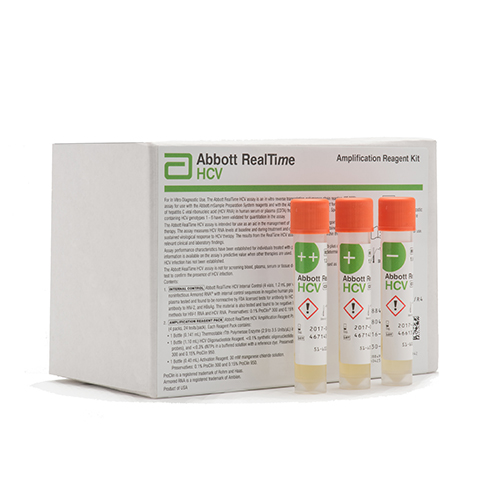EOT = end of treatment (week 12, 24, or 48). For IFN-free therapy regimens, week 2 testing is for patient adherence. VL = Viral Load, GT = Genotype, SVR = Sustained Virologic Response. For IFN-free therapy regimens, week 2 testing is for patient adherence, week 12 is assumed end of treatment (ED).EASL Clinical Practice Guidelines,Journal of Hepatology 2014 vol. 60 j 392-420. EASL HVC Treatment Recommendations, April 2014. Available at http://www.easl.eu/_newsroom/latest-news/easl-recommendations-on-treatment-of-hepatitis-c-2014. Accessed January 9, 2015. AASLD/IDSA/IAS-USA. Recommendations for testing, managing, and treating hepatitis C. http://www.hcvguidelines.org. Accessed on January 29, 2014. AASLD/IDSA HCV Guidance Panel (2015), Hepatitis C guidance: AASLD-IDSA recommendations for testing, managing, and treating adults infected with hepatitis C virus. Hepatology, 62: 932–954. doi:10.1002/hep.27950
Indications and Limitations of Use
Intended Use
The Abbott RealTime HCV assay is an in vitro reverse transcription-polymerase chain reaction (RT-PCR) assay for use with the Abbott mSample Preparation System reagents and with the Abbott m2000sp and m2000rt instruments for the quantitation of hepatitis C viral (HCV) RNA in human serum or plasma (EDTA) from HCV-infected individuals. Specimens containing HCV genotypes 1 – 6 have been validated for quantitation in the assay.
The Abbott RealTime HCV assay is intended for use as an aid in the management of HCV-infected patients undergoing antiviral therapy. The assay measures HCV RNA levels at baseline and during treatment and can be utilized to predict sustained and non-sustained virological response to HCV therapy. The results from the RealTime HCV assay must be interpreted within the context of all relevant clinical and laboratory findings.
Assay performance characteristics have been established for individuals treated with peginterferon alfa-2a or 2b plus ribavirin. No information is available on the assay’s predictive value when other therapies are used. Assay performance for determining the state of HCV infection has not been established.
The Abbott RealTime HCV assay is not for screening blood, plasma, serum or tissue donors for HCV, or to be used as a diagnostic test to confirm the presence of HCV infection.
Limitations of the Procedure
- Human serum and plasma specimens (EDTA) may be used with the Abbott RealTime HCV assay. The use of other anticoagulants has not been validated with the Abbott RealTime HCV assay.
- Though rare, mutations within the highly conserved regions of the viral genome covered by the Abbott RealTime HCV assay primers and/or probe may result in the under-quantitation of or a failure to detect the presence of the virus in this circumstance.
- A specimen with a result of “Not Detected” cannot be presumed to be negative for HCV RNA.
- Precision was established with HCV Genotypes 1 and 3 only.
- As with any diagnostic test, results from the Abbott RealTime HCV assay should be interpreted in conjunction with other clinical and laboratory findings.
- Due to inherent differences between technologies, it is recommended that, prior to switching from one technology to the next, users perform method correlation studies in their laboratory to quantify technology differences.
Warnings and Precautions
The Abbott RealTime HCV assay is not for screening blood, plasma, serum or tissue donors for HCV, or to be used as a diagnostic test to confirm the presence of HCV infection.
Caution: United States Federal law restricts this device to sale and distribution to or on the order of a physician or to a clinical laboratory; and use is restricted to, by, or on the order of a physician.
References
- Wiesmann F et al. Variation analysis of six HCV viral load assays using low viremic HCV samples in the range of the clinical decision points for HCV protease inhibitors. Med Microbiol Immunol. 2015 Aug;204(4):515-25. DOI 10.1007/s00430-014-0364-z. Epub 2014 Nov 15.
- Adapted from Wiesmann F et al. Poster #465. ESCV 2013. Comparison of viral load assays for the quantification of HCV genotypes 1-4 in the setting of low viremic samples.
- European Association for the Study of the Liver. EASL Clinical Practice Guidelines: Management of hepatitis C virus infection. J Hepatol. 2014; 60(2):392-420.


